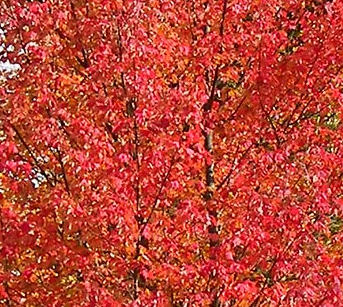Columnar trees are perfect for incorporating color, grace, and beauty into a garden setting. When they border driveways, grow along fences, or serve as a privacy hedge, tall, slender trees produce a dramatic visual impression. Some dwarf columnar trees can be grown in pots and placed by a gateway or gate to create a lovely visual impression. Due to their upright, columnar form, columnar trees are a great choice for landscaping both large and small yards.
Columnar Norway Maple is generally prized for its stiff columnar structure in the landscape. It is mostly covered in gorgeous corymbs of lemon yellow blooms along the branches in early spring before the leaves appear. Its foliage is dark green and deciduous. The lobed leaves become yellow in autumn.
Columnar Norway Maple is a thick deciduous tree that grows narrowly straight and columnar. Its relatively rough texture helps it stand out from similar landscaping plants with finer foliage.
Columnar Maple Size
Columnar maple trees are tall and slender, making them ideal for use as a screen or close to buildings. In the spring, the erect crown is covered in greenish-yellow blossoms. Lateral branches are short and practically horizontal in growth, which is unusual for a columnar tree. This cultivar, originally from France, features a crown that looks like an egg. The tree develops a columnar shape as its branches mature and become more upright.
This tree’s columnar crown makes it ideally suited for avenues and narrow streets. Rootstock-grafted trees stay smaller than root collar-grafted trees. These typically develop into multiple-stemmed trees. In their unfolding state, the leaves are brownish-red, but in the fall, they turn yellow. The inflorescence is abundant, and the blooms are frequently visited by bees. Similar to ‘Columnarbroad,’ this cultivar is highly tolerant of all soil types, however, it does not grow in moist soil. it is extremely adaptable to urban environments. The tree is effectively wind-resistant.
Columnar Maple Growth Rate
The mature height and width of this columnar maple are approximately 40 feet and 15 feet, respectively. It possesses a modest canopy with a normal ground clearance of 5 feet and is not planted beneath power lines. It is expected to survive to a ripe old age of 100 years or more in suitable conditions; this tree is often considered a living memorial for generations to come.
Columnar Maple Care
This tree enjoys full light but is able to thrive in partial shade as well. However, full sun is ideal for its growth. A Norway maple thrives in a wide range of soil conditions, but it does best in rich, well-drained soil. It is also essential to use caution while planting Norway maples near water, as they are implicated as invasive species. Roots often grow at the surface. In the winter, young trees with brittle bark are susceptible to cracking if a sunny day follows a cold spell.
Columnar Maple Root System
The shallow root structure of the Norway maple makes it difficult to mow the lawn around the tree. Be sure to plant the tree four to six feet away from any buildings or walkways because its weak roots cause damage. The tree is easy to transplant, grows quickly, is tolerant of a wide range of soils (even alkaline), and displays a spectacular golden fall color. It is also able to survive in coastal environments. This tree is a good choice for planting in urban areas with limited vertical space due to its narrow crown.
Columnar Maple Problems
Populations of Norway maple overrun places by displacing native shrubs, trees, and herbaceous understory species and, once established, by producing a dense shadow canopy that limits the regeneration of native seedlings; it is also believed to generate root toxins that impede or block the growth of other plants.
Aphids frequently infest maples, typically Norway maple, and their numbers often fluctuate. Leaf drop also results from high populations. Honeydew on the lower leaves and items beneath the tree is another indicator of aphid infestation. Spraying them with insecticide or simply ignoring them are two options for dealing with aphids. Aphids are controlled by predators if not sprayed.
Maple trees occasionally experience scale issues. Cottony maple scale is among the most frequent. The insect produces a cottony mass on the undersides of branches where it lives. Horticultural oil sprays are frequently used to reduce scales. Sprays that kill crawlers are also used to eliminate scales.



